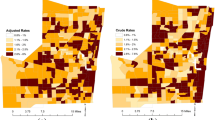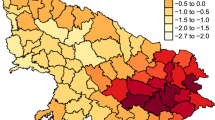Abstract
Background
Spatial modeling of rare diseases, such as childhood cancer, has been hampered by imprecise risk estimates. Recent developments in Bayesian hierarchical modeling include the ability to adjust a disease risk estimate to be fully conditional for covariance among neighboring locations and for covariance among multiple diseases within each location. This joint modeling approach is called Multivariate Intrinsic Conditional Autoregressive. The objective of this study was to evaluate the spatial and histotype covariance among childhood cancer histotypes, in Texas. Results will be valuable for selecting appropriate models to support more specific etiologic studies of environmental factors for childhood cancer.
Methods
County level standard morbidity ratios for 13 childhood cancer histotype groups were estimated using Multivariate Intrinsic Conditional Autoregressive modeling and the results compared to results from two reduced models. The two reduced models were the base model specified with zero spatial covariance and the base model specified with zero histotype covariance. The results were compared using the Deviance Information Criterion and Geographical Information System techniques were used to compare patterns of standard morbidity ratios.
Results
Including histotype covariance greatly improved the Deviance Information Criterion and including spatial covariance produced a moderate improvement. Parameter evaluation by GIS techniques showed that excluding histotype covariance resulted in marked shrinkage of the risk estimates.
Conclusions
Investigation of childhood cancer could benefit by incorporating histotype covariance into environmental modeling.

Similar content being viewed by others
References
Short M, Carlin BP, Bushhouse S (2002) Using hierarchical spatial models for cancer control planning in Minnesota (United States). Cancer Causes Control 13:903–916
Lawson AB, Bohning D, Biggeri A, Lesaffre E, Viel JF (1999) Disease mapping and its uses. In: Lawson A, Biggeri A, Bohning D, Lesaffre E, Viel J-F, Bertollini R (eds) Disease mapping and risk assessment for public health. Wiley, New York, NY, pp 3–13
Willis A, Krewski D, Jerrett M, Goldberg MS, Burnett RT (2003) Selection of ecologic covariates in the American Cancer Society Study. J Toxicol Environ Health A 66:1563–1589
Roux AVD (2004) The study of group-level factors in epidemiology: rethinking variables, study designs, and analytical approaches. Epidemiol Rev 26:104–111
Best N, Richardson S, Thomson A (2005) A comparison of Bayesian spatial models for disease mapping. Stat Methods Med Res 14:35–59
Banerjee S, Carlin BP, Gelfand AE (2004) Overview of spatial data problems. Hierarchical modeling and analysis for spatial data. Chapman & Hall/CRC, Boca Raton, pp 1–20
Spiegelhalter D, Thomas A, Best N, Lunn D (2003) WinBUGS user manual: Version 1.4. MRC Biostatistics Unit, Cambridge
Carlin BP, Louis TA (2000) Bayes and empirical Bayes methods for data analysis. Chapman & Hall/CRC, New York
Besag J, York JC, Mollie A (1991) Bayesian image restoration, with two applications in spatial statistics (with discussion). Ann Inst Stat Math 43:1–59
Assuncao RM, Castro MSM (2004) Multiple cancer sites incidence rates estimation using a multivariate Bayesian model. Int J Epidemiol 33:508–516
Kramarova E, Plesko I, Black RJ, Obsitnikova A (1996) Improving survival for childhood cancer in Slovakia. Int J Cancer 65:594–600
Thomas A, Best N, Lunn D (2003) GeoBUGS User Manual Version 1.2. MRC Biostatistics Unit, Cambridge
Spiegelhalter DJ, Best NG, Carlin BP, van der Linde A (2002) Bayesian measures of model complexity and fit (with discussion). J R Stat Soc B 64:1–34
Reynolds P, Von Behren J, Gunier RB, Goldberg DE, Hertz A, Harnly ME (2002) Childhood cancer and agricultural pesticide use: an ecologic study in California. Environ Health Perspect 110:319–324
Reynolds P, Von Behren J, Gunier RB, Goldberg DE, Hertz A, Smith DF (2003) Childhood cancer incidence rates and hazardous air pollutants in California: an exploratory analysis. Environ Health Perspect 111:663–668
Reynolds P, Von Behren J, Gunier RB, Goldberg DE, Harnly M, Hertz A (2005) Agricultural pesticide use and childhood cancer in California. Epidemiology 16:93–100
Reynolds P, Von Behren J, Gunier R, Goldberg DE, Hertz A (2005) Agricultural pesticides and lymphoproliferative childhood cancer in California. Scand J Work Environ Health 31:46–54
Morris RD, Munasinghe RL (1993) Aggregation of existing geographic regions to diminish spurious variability of disease rates. Stat Med 12:1915–1929
Knox EG (2005) Childhood cancers and atmospheric carcinogens. J Epidemiol Community Health 59:101–5
Maisonet M, Correa A, Misra D, Jaakkola JJK (2004) A review of the literature on the effects of ambient air pollution on fetal growth. Environ Res 95:106–15
Sram RJ, Binkova BB, Dejmek J, Bobak M (2005) Ambient air pollution and pregnancy outcomes: a review of the literature. Environ Health Perspect 113:375–382
Buffler PA, Kwan ML, Reynolds P, Urayama KY (2005) Environmental and genetic risk factors for childhood leukemia aising the evidence. Cancer Invest 23:60–75
Acknowledgments
Financial support for this study was provided by the National Institutes of Health and the National Cancer Institute through Grant number R03 CA106080.
Author information
Authors and Affiliations
Corresponding author
Rights and permissions
About this article
Cite this article
Thompson, J.A., Carozza, S.E. & Zhu, L. An evaluation of spatial and multivariate covariance among childhood cancer histotypes in Texas (United States). Cancer Causes Control 18, 105–113 (2007). https://doi.org/10.1007/s10552-006-0085-8
Received:
Accepted:
Issue Date:
DOI: https://doi.org/10.1007/s10552-006-0085-8





